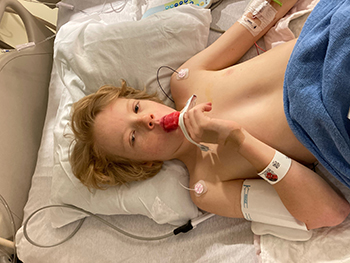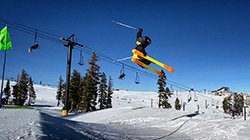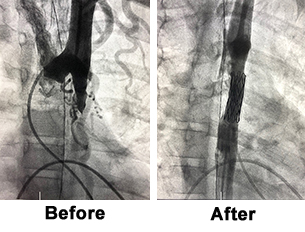Boy receives life-changing cardiac catheterization for rare heart condition
Coarctation of the aorta with complete obstruction wasn’t discovered until he was 12
It was an extremely rare case that many pediatric cardiologists may see once in their career or not at all.

Twelve-year-old Dane Gaffney came to the UC Davis pediatric cardiology clinic last month with high blood pressure and a heart murmur.
An initial ultrasound of his heart showed a congenital heart defect (CHD) called coarctation of the aorta (COA). He was brought to the Cath Lab. An aortic angiogram (a test that uses X-ray imaging to see blood vessels in the heart) revealed that Dane, in fact, had no blood flow down the aorta, the major vessel that supplies blood to the lower half of his body. Instead, multiple tiny collateral vessels came off the aorta in the upper half of the body, made their way through the chest and re-entered the lower half of the aorta. This severe abnormality is usually caught early in infancy and if left untreated as an infant, is fatal.
“The fact that he made it to the age of 12 without any symptoms of having this congenital heart defect is unfathomable, especially since he was so active in sports. His body had an uncanny way of maintaining blood flow to the lower body via a vast network of tiny collateral vessels,” said Frank Ing, chief of pediatric cardiology at UC Davis Children’s Hospital.
Dane enjoys basketball, mountain biking and skiing. His congenital heart defect never slowed him down.
COA occurs when a part of the aorta (the main artery that carries blood from the heart to the body) is narrowed. In Dane’s case, a part of the aorta most likely started as a narrowing and progressed to becoming completely blocked. Ing suspects that it probably occurred over a long period of time, allowing his body to develop a network of pathways to get blood around the blockage.

Dane Gaffney skiing this past winter.
“The analogy of this problem is this: A 10-lane highway is like the aorta and cars going along the highway is the blood. If there’s an accident and eight lanes are blocked with only a two-lane highway for cars to drive through, what do the cars do?” Ing asked.
“They exit off the freeway and take local streets and alleys until they can get back on the highway further down where it’s opened back up. The local streets and alleys are the collaterals. In Dane’s extreme case, the highway was completely blocked, but his body was able to make many small collaterals, so he didn’t have any symptoms other than high blood pressure.”
To open up the proverbial highway again, Ing performed an interventional cardiac catheterization.
Ing inserted two tiny catheters into two blood vessels from Dane’s groin, one to the aorta above the blockage and one below the blockage. He used a thin, stiff wire to thread across the blockage from above into the lower aorta and then snared that wire with the catheter in the lower aorta. Using the wire as a rail, Ing initially inflated a tiny balloon at the blockage to widen the area and then serially enlarged the area with sequentially larger balloons. Finally, he implanted a covered stent to keep the vessel open.
The procedure took more than seven hours and successfully repaired Dane’s heart defect. Dane was left with no scars, except for two tiny puncture holes where the catheters were inserted. Dane stayed in the hospital overnight and was released the next day. No big open-heart surgery to recover from since the procedure was minimally invasive. His blood pressure normalized immediately after the procedure.

Images of Dane’s aorta before and after the stent implant. In the second image, notice the tiny collateral vessels are gone and the main vessel is wide open.
“Everyone at UC Davis Children’s Hospital was great. The thing I liked the most was that the doctors and nurses spoke directly to Dane, making sure that he knew what was going on, instead of only talking directly to Scott and me. I thought that was really cool,” said Dawn Gaffney, Dane’s mother.
Dane will continue to be monitored by Ing as he grows. No surgeries are in his future.
As Dane grows into adulthood, the implanted stent will be further widened to accommodate his growth. Fortunately, all future procedures can be interventional and non-surgical, which can be completed in the Cath Lab. The stent that Ing selected can be further dilated to the normal adult-size aorta. Currently, Dane is scheduled to have another Cath procedure in six months to further widen the stent.
“Dane is pretty much back to normal now,” said Dane’s dad Scott Gaffney. “He can’t do anything jarring for the next six weeks but then he can gradually get back to normal activity. We are extremely thankful.”



